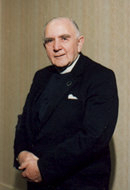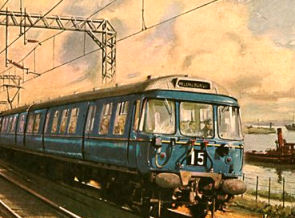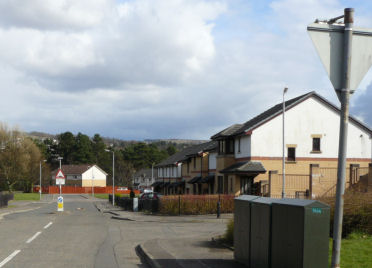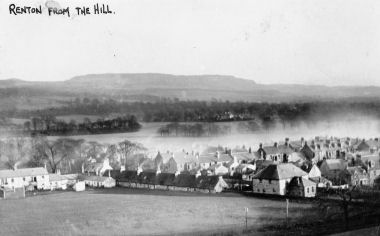RENTON A BRIEF HISTORY from 1715 to 2008 - Page 5
Page 1 | Page 2 | Page 3 | Page 4
Renton was a bustling, prosperous small town of about 5,000 people. There was a “feel good” factor around the success and prosperity in Renton in the 1950's.  An “outsider” who added to the general community spirit - the Reverend James Currie, minister of Millburn Church, made a significant contribution to it. Jimmie didn't actually spend very long in Renton, but he did seem to cram in a great deal of diverse activity.
An “outsider” who added to the general community spirit - the Reverend James Currie, minister of Millburn Church, made a significant contribution to it. Jimmie didn't actually spend very long in Renton, but he did seem to cram in a great deal of diverse activity.
He never turned anyone away from his door, regardless of religion, and he got help from all sorts of unexpected sources. When he needed a loudspeaker system for his summer evening services in the big square in Cordale, the Communist Party provided one. According to Jimmie, God and Renton sometimes worked in very mysterious ways indeed.
There were social problems certainly, mainly based on housing conditions, exacerbated by the post-war baby boom. Gaps sites had appeared in Renton because of the demolition of slum properties in the 1930's, but no major land area was quickly available for industrial-scale new house building, which was urgently required. That land lay elsewhere in the Vale at Dalmonach in Bonhill and Tullichewan Alexandria, in the late 1940's, and the Haldane in Balloch from the 1950's onwards. The solution adopted by the council was arguably the only one open to them at the time - rehouse the Renton people on the housing waiting list in these new schemes.
In the event many Renton families moved to Dalmonach in the late 1940's and then to Haldane in the 1950's onwards. This certainly led to a decline in the population of Renton, but it created the opportunity for wholesale clearance of the older housing stock and the redevelopment of the freed up land with new, modern council houses. From the late 1950's that plan was put into effect, and by the early 1960's much of the old Renton, not just in Back Street and the various older streets around the Cross, but also along the whole length of Main Street, had been redeveloped.
The immediate impact was to change the character of Renton completely. All of the property on the east side of Main Street from Stirling Street to the School Green was demolished, and none of it from Burn Street south was replaced (until now with the building of very sheltered accommodation on the southern corner of Burn Street / Main Street). At the same time most of the houses and shops on the western side of side of Main Street, although not them all, from Red Row to the end of southern end of Lennox Street were also pulled down.
In the place of all of this came bland, stereotyped housing of a type seen all over Scotland. In the case of the shops, the situation was much worse. The small businesses which operated out of premises that were either owned by the shopkeeper or rented at nominal rents, were faced with renting premises at a cost in rent and rates that reflected the new build. There were very few takers for new premises, and only a handful of shops were built between Thimble Street and Burn Street on the east side of Main Street, and between King Street and Red Row on the west side. A few other shops survived further south as well as a new chemist shop.
Within a couple of years in the early 1960's, Renton went from having about 80 shops to having about a dozen, the number of pubs halved, and these numbers have fallen even more with subsequent developments. No streets were lost in the redevelopment of the early 1960's although some such as Burn Street were stripped pretty bare. A number of new, short thoroughfares were created such as Bilsland Place, Grant Crescent and Kane Street around Back Street in the centre of the village, and McNaught Place and McKim Walk at the south end.
At the time, people were pleased with the housing - it addressed the remaining housing needs - but a slow realisation dawned that the character of Renton had been irrevocably changed. Also in the early 1960's Renton returned briefly to the  national headlines. The railway line had just been electrified and the Blue Trains started running in November 1960. However, on 13th December 1960, the electricity transformer on the 7.30 Balloch to Bridgeton Cross train exploded, just after it had drawn away from Renton station and was approaching Wylie Park. The guard and 2 passengers were seriously injured, with another 5 suffering minor injuries. There was a major design fault in the automotive system and the Blue trains had to be withdrawn for about a year while it was fixed.
national headlines. The railway line had just been electrified and the Blue Trains started running in November 1960. However, on 13th December 1960, the electricity transformer on the 7.30 Balloch to Bridgeton Cross train exploded, just after it had drawn away from Renton station and was approaching Wylie Park. The guard and 2 passengers were seriously injured, with another 5 suffering minor injuries. There was a major design fault in the automotive system and the Blue trains had to be withdrawn for about a year while it was fixed.
On the social front at that time, Rentonians were growing uneasy that parts of Renton were being used to house problem families from other areas, especially outwith the Vale, a perception that remains to this day. It gained weight in the early 1970's when the council decided that Cordale was a major problem area in need of drastic action. A fundamental refurbishment of the Cordale houses was carried out at great expense, and in an attempt to shake off negative connotations, Cordale was renamed “Kirkland” after Dr John Kirk. Dr Kirk had been the leading GP serving the people Renton for almost 40 years and was universally held in great respect and affection by Rentonians - it could hardly be otherwise when he had brought so many of them into the world.
 It was hoped that the new name would help regenerate the estate. However, things had gone way beyond a simple re-spray, and after a few years, defeat was admitted. The name Kirkland was dropped and much of Cordale was flattened. At the same time, the Vale was experiencing another economic downturn. The Torpedo Factory had closed, as had Burroughs and Wiseman's on the Industrial Estate, and Westclox were laying
It was hoped that the new name would help regenerate the estate. However, things had gone way beyond a simple re-spray, and after a few years, defeat was admitted. The name Kirkland was dropped and much of Cordale was flattened. At the same time, the Vale was experiencing another economic downturn. The Torpedo Factory had closed, as had Burroughs and Wiseman's on the Industrial Estate, and Westclox were laying  people off. Although Polaroid was certainly taking up some of the slack, unemployment, particularly youth unemployment, was on the rise.
people off. Although Polaroid was certainly taking up some of the slack, unemployment, particularly youth unemployment, was on the rise.
The late 1980's was arguably Renton's lowest post-war point when people began to feel the physical spaces, the anti-social behaviour coming from a small but well-entrenched group, the declining population and the growing poverty. It perhaps felt to some that Renton just didn't have a sustainable future. But again, cometh the hour, cometh the man. A group of Rentonians recognised that the best way forward was to define their own solutions, and then use the system to implement these solutions.
Councils, even well-intentioned ones, had created the problems with a range of redevelopment schemes which looked good on paper, but hadn't worked  wherever they were tried - Alexandria and Dumbarton
town centres were ample evidence of that, as was Kirkland. So in 1993, a new approach to Renton development and regeneration was decided upon. Renton Residents took the lead in creating The Cordale
Housing Association (the “CHA “). With Archie Thomson in the chair, and with a little outside help, they formed not only its membership, but also its management committee.
wherever they were tried - Alexandria and Dumbarton
town centres were ample evidence of that, as was Kirkland. So in 1993, a new approach to Renton development and regeneration was decided upon. Renton Residents took the lead in creating The Cordale
Housing Association (the “CHA “). With Archie Thomson in the chair, and with a little outside help, they formed not only its membership, but also its management committee.
From the outset it had an ambitious objective “we won't build a better standard of housing for people to enjoy their poverty in”. However, it had to start somewhere, and that was in building and managing attractive modern houses, mainly for rent, which Rentonians are proud to live in.
Most of the initial funding came from central government through its social housing agency - now called Communities Scotland. There was also input from and co-ordination with the local authority. However, the driving force and day-to- day management is all based in Renton, now more than ever. The CHA's initial project was building a new Cordale on the site of the old Kirkland / Cordale.
day management is all based in Renton, now more than ever. The CHA's initial project was building a new Cordale on the site of the old Kirkland / Cordale.
Within a year, people were occupying the first of the new houses in the new layout of Cordale. As well as some surviving street names from the old estate, a number of new ones named after Renton heroes and heroines such as Kelso (World football champion and Scottish internationalist), Katherine (Poetess Katherine Drain), Hannah (World football champion and Scottish internationalist) and Gallacher (Skeets, one of the best flyweight boxers in the world in his day) have been built.
The CHA has been an outstanding success, as well as perhaps Scotland's best-kept secret in urban regeneration. Of the 1,000 or so homes in Renton, (almost the same as in 1930) 370 are now managed by the CHA. It presently has a waiting list of over 300 people and very little turnover. In addition, in a poll of its residents / members carried out earlier this year, 98% said that they were very happy with the service they receive with the CHA and had no complaints whatsoever.
The £38 million it has invested in Renton over the last 13 years has obviously provided an excellent return to the community. In addition, in the last year or so it has been able to diversify from straight social housing into sheltered housing, firstly with the purchase of Leven Cottage in Alexandria, which West Dunbartonshire Council wished to close, and also with the building of a very sheltered accommodation residence with 40 apartments on the corner of Burns Street and Main Street, which will open in June 2008, so that the people of Renton can see out their twilight years in their own community.
Perhaps the CHA's most ambitious project to date, the redevelopment of the former Dalquhurn Works site is now under way in conjunction with building, design and technical partners. The aim is to have a mix of about 280 rental / sale houses in a very attractive location available for occupancy by 2010. Renton's leadership and innovation carries it into the future with a degree of quiet confidence which others can only wish for.
NOTE ON SOURCES
None of the general histories of the Vale does Renton full justice - in fact John Neill's Records and Reminiscences of Bonhill Parish (1912, reprinted 1979) which is so useful for the rest of the Vale, specifically excludes Renton since it is not in Bonhill Parish).
As ever, Rantonians took the matter into their own hands. Firstly with the Renton History Project's: Renton “Oor Ain History” which was published in the late 1980's and is largely interviews with Rentonians of that time.
A second book is even more recent, Jim Murphy's “Renton Between the Wars 1914 - 18 and 1939-45” although it covers much more ground than that. It was published in September 2007 and the Publisher is the Carman Centre, from whom this book can be ordered. Sadly Jim died in April 2008, but by that time the deserved great success of the book was already evident. It cannot be praised or recommended too highly and it is required reading for everyone interested in the Renton - full of 20th century detail, maps and anecdotes. If you're looking for something about Renton in the 20th Century, chances are that it is in this book.
RENTON MAIN STREET 1939 - 45
This is a list of the businesses in Renton, 1939 - 45, drawn up anonymously in the early 1990's.
A WALK ALONG RENTON MAIN STREET, 1939 - 1945.
- Coming into Renton from Dumbarton. On the left hand side of the road is Wylie Park, and then a block of red sandstone flats which contained Ritchie the Bookie. On the other end of the block, round the back add up the stairs was the Dentists.
- Park Street, then on Main Street, Conroy's Sweetie Shop, the Library, the Roxy - better known as the Flea Pit.
- Hall Street. A small Sweetie Shop. Back onto Main Street. Two Coop Shops, Mary the Bakers, Bain's Fruit Shop, Jessamines Sweetie Shop.
- Carman Road. The Bowling Green, then on Main Street again, Ferguson's Paper Shop, a Millinery Shop, McQuilkie's Fruit Shop. Renton Public School, Brannon's Paper Shop, the Black Bull Pub.
- Station Street. McFarlane the Bakers, Maggie McLean's Paper Shop, McDougall's Pub, Cobblers Shop, Thompson's Pub, Millinery Shop, Hughie the Butchers, the Pawn, Galbraith's, Coop Butchers, Coop Tailors, Mrs Cook's grocery, McBirnies pub.
- King Street. Allan's the Grocers, Butchers shop, Pannettas Chip Shop, Old Libbys Paper shop, Mary Coopers Ironmongers, Mary the Bakers, McKenzie's Butchers, Middleton's Sweet Shop, Johnny Antonelli's Barbers Shop, Miss Layton's Clothes Shop, the Auld Hoose pub, Bella McKellars Sweetie Shop,
- Red Row. Then Willie McKim's Sweetie Shop, Lizzie Connolly's Bowling Green Tavern.
- Cardross Road. Millburn Church, and Churchyard, which was still open for some burials in existing lairs, St Martins Primary School, St. Martins.
Chapel.
There were two more shops in the Back Street and a dairy, Dunky Urie's and McKay the barber. - Coming from Alexandria to Renton, on the left hand side of the road, this was before Cordale housing scheme was built, there was just a big wall from Turnbulls Loan to Stirling Street. The wall carried on down Stirling Street to the Waterside.
- Shops on the Main Street from Stirling Street were Tony Gargaro's Chip Shop, Hasties Chip Shop, Miss Cooper's Clothes Shop.
- Thimble Street. Mary Connolly's Fruit shop, Wet Fish shop, Coop Bakers, Post Office, McKim the Photographer, Cleary the cobblers.
- Burns Street. Barr's Pub, the Bank, Miss Weirs shop, Cycle shop, Templeton's Grocers, Jimmy Baxter Barber, Ewings Dairy, Coop Grocers, Coop Shoe shop, Coop Butchers, Coop Fruit shop, Sweet Shop, Coop chemist, McDougall's Painters, McGowan's Chip shop, Leek Cafe.
- John Street. Butchers shop.
- Leven Street. Sweetie shop.
- Tontine houses, the War Memorial.
We would of course be grateful for any additions or corrections to this list.
Page 1 | Page 2 | Page 3 | Page 4



